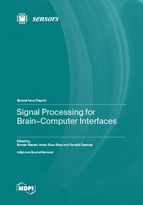Signal Processing for Brain–Computer Interfaces
A special issue of Sensors (ISSN 1424-8220). This special issue belongs to the section "Wearables".
Deadline for manuscript submissions: closed (30 December 2023) | Viewed by 36685
Special Issue Editors
Interests: brain–computer interface; machine learning; deep learning; classification
Special Issues, Collections and Topics in MDPI journals
Interests: neurorehabilitation; biomedical signal processing; machine learning; applied artificial intelligence; EEG; EMG
Special Issues, Collections and Topics in MDPI journals
Interests: functional near-infrared spectroscopy (fNIRS) data processing; statistical analysis for fNIRS signal; multi-modal neuroimaging; brain-computer interface (BCI) applications
Special Issues, Collections and Topics in MDPI journals
Special Issue Information
Dear Colleagues,
You are cordially invited to contribute to the Special Issue on “Signal Processing for Brain–Computer Interfaces”. Signal processing in brain–computer interface (BCI) systems includes noise removal, feature extraction, and classification. Noise removal algorithms aim to eliminate or reduce several different types of noise, including physiological noises, instrument noises, motion artifacts, power line noises, and noises due to interference with other devices. In feature extraction, task related features are acquired in spatial, temporal, and spectral domains using different algorithms. Finally, the goal of classification is to translate extracted features into commands for the control of external devices.
This Special Issue shall focus on state-of-the-art noise removal, feature extraction, and classification techniques to improve the accuracy, reliability, information transfer rate, and general performance of BCI systems which may be based for invasive or non-invasive methods, for example, implanted electrodes, electrocorticography (ECoG), electroencephalography (EEG), functional near-infrared spectroscopy (fNIRS), and hybrid brain imaging techniques. Original research papers, clinical studies, and review papers which describe new research on signal processing for BCIs are all welcome. I look forward to your participation in this Special Issue.
Dr. Noman Naseer
Dr. Imran Khan Niazi
Dr. Hendrik Santosa
Guest Editors
Manuscript Submission Information
Manuscripts should be submitted online at www.mdpi.com by registering and logging in to this website. Once you are registered, click here to go to the submission form. Manuscripts can be submitted until the deadline. All submissions that pass pre-check are peer-reviewed. Accepted papers will be published continuously in the journal (as soon as accepted) and will be listed together on the special issue website. Research articles, review articles as well as short communications are invited. For planned papers, a title and short abstract (about 100 words) can be sent to the Editorial Office for announcement on this website.
Submitted manuscripts should not have been published previously, nor be under consideration for publication elsewhere (except conference proceedings papers). All manuscripts are thoroughly refereed through a single-blind peer-review process. A guide for authors and other relevant information for submission of manuscripts is available on the Instructions for Authors page. Sensors is an international peer-reviewed open access semimonthly journal published by MDPI.
Please visit the Instructions for Authors page before submitting a manuscript. The Article Processing Charge (APC) for publication in this open access journal is 2600 CHF (Swiss Francs). Submitted papers should be well formatted and use good English. Authors may use MDPI's English editing service prior to publication or during author revisions.
Keywords
- brain–computer interface
- signal processing
- EEG
- fNIRS
- classification
- noise removal
- feature extraction
- machine learning
- filtering techniques
- deep learning









